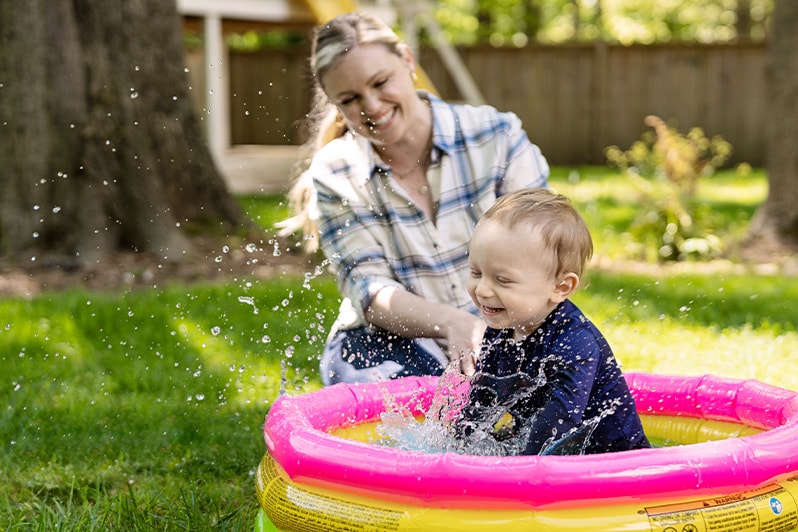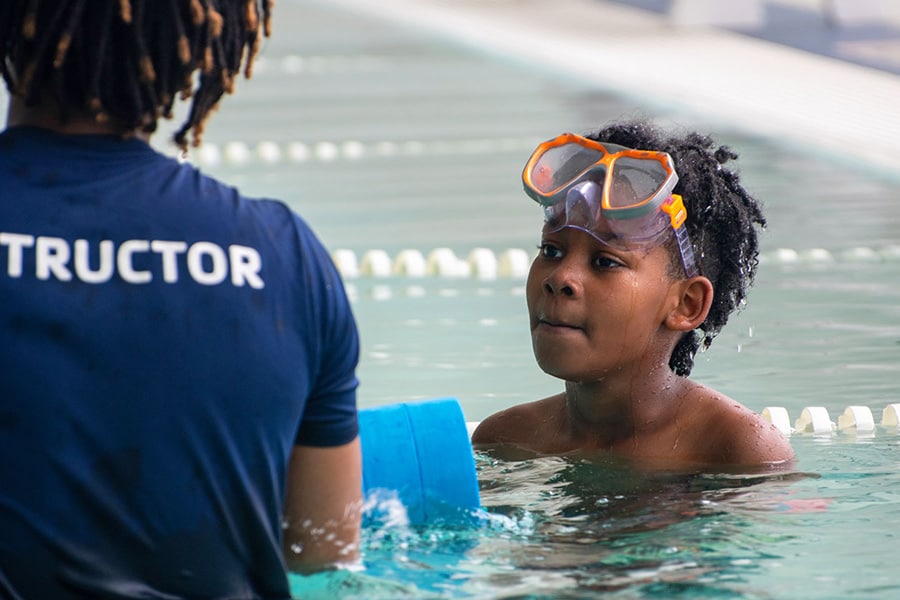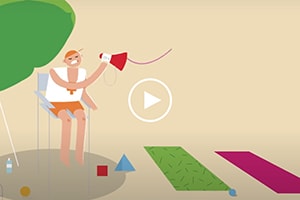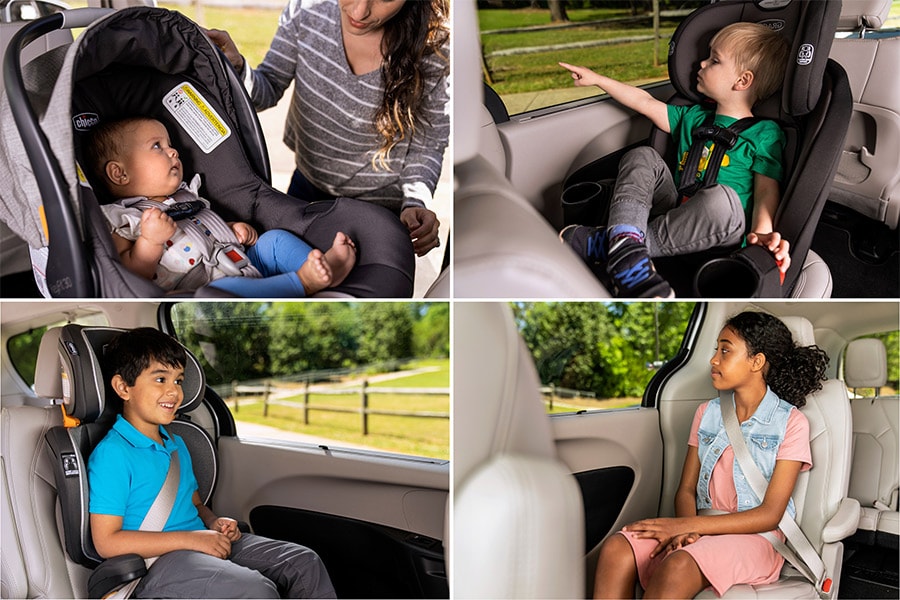Bath Time and Bath Safety FAQs
Bath time is a central part of your family’s routine. It can be a fun time to bond and play. It may be a soothing part your bedtime ritual. Or it could be stressful if your little one doesn’t enjoy the bath. Whether you have a newborn or toddler, and whether bath time is a joy or a challenge, we can help with expert answers to common bath time questions.

Frequently asked questions about bath time
I have a newborn and need to know when to give my baby their first bath.
You can start bathing your baby as soon as you want, but remember not to get their umbilical cord stump wet. Start with sponge baths. Once the umbilical cord stump falls off, you’re ready to put your baby in the water.
How often do babies need baths?
For the first year, you only need to bathe your baby about 2 times per week. You may not need to wash their hair for a while, but once it begins getting thick, use a mild shampoo. As your little one grows into a toddler, you can bathe them 2 to 3 times per week. If they get a little extra messy one day, it’s OK to add an extra bath here and there as needed.
How much water do I use to bathe my baby?
We recommend using no more than about 2 inches of water.
What soap do I use to bathe my baby?
All newborn babies need for a bath is plain, lukewarm water. When your infant is a few weeks old, you can start using fragrance-free baby soap and shampoos. But a little goes a long way! Soaps and shampoos can make babies’ skin dry and irritated, so be sure to rinse them off your baby’s skin right away.
How do I clean my baby in the bath?
Clean babies gently. Similar to a sponge bath, use a soft washcloth to wash your baby’s face, neck and ears. Wash the rest of their body from the top down. Without scrubbing or tugging, massage their scalp. Cup your hand over their face to rinse soap or shampoo without getting it in their eyes. Once your little one is a toddler, you can also use a bath visor to keep water and soap out of their eyes.
Can babies take oatmeal or Epsom salt baths?
Your baby doesn't need anything special in their bath. Keep it simple! If you’re concerned about your baby’s skincare, or notice a rash or abnormal bumps, contact your pediatrician.
Does bathing make eczema worse?
Certain soaps and too much time in warm water can make irritation worse. This can be especially true in winter, when the air is extra dry. If you notice irritation, try to limit your child's bath to less than 10 minutes, use lukewarm water, and wash soaps and shampoos off twice to ensure a thorough rinse. Contact your pediatrician for specific product recommendations.
How do I get rid of cradle cap?
You may notice thick, flaky or scaly skin on your baby’s scalp. This is called cradle cap or crib cap. The good news is that it’s common, mostly harmless and tends to go away on its own. While most of the time cradle cap won’t bother your infant, it can be irritating if severe. There are several household remedies, including baby oil, mineral oil and gentle baby shampoos. For more severe cases, a prescription cream, ointment or shampoo may be necessary. Talk with your pediatrician about any serious concerns.
How soon after circumcision can baby have a bath?
It’s important to ask your baby’s doctor for their recommendations, as each baby is different. Depending on the instrument used and what your doctor recommends, timelines for bathing after circumcision can vary.
Can I bathe my baby after feeding?
While it's good to have a routine for bathing and feeding your infant, there is no harm in bathing your infant after feeding. However, if your baby spits up frequently, it may be better to wait a bit after their feed, so they don't need another bath later.
Can I bathe my baby while they’re sleeping?
Bath time is an exciting time for bonding, and it’s easier to keep your baby safe while they are awake, so it's better for both you and your little one to bathe while they are awake. Plus, they will most likely wake up once you put them in the bath.
What do I do if my baby poops or pees in the bath?
It’s common and normal for babies to pee or poop in the bath. So if it happens, don’t worry! Urine is sterile, so you can either drain the bath or keep moving, being careful not to get water in your baby’s mouth. If your child poops in the tub, remove your child from the tub and drain the water. Remove the stool, clean the tub with soap and water, and start the bath again.
Is bubble bath safe for babies? What about toddlers?
While bubbles are certainly fun, we recommend waiting until your child is around 3 years old to use them. Before then, bubble baths can irritate little ones’ sensitive skin. Using tear-free and fragrance-free bubbles will limit irritation, but avoid bubbles altogether if your child has dry skin or eczema.
How can I keep my child warm while bathing?
Aim for bathwater that’s comfortably warm, but not hot (around 95°F). Ensure that the water temperature is no higher than 120°F. To keep your little one warm outside the bath, use warm, cozy towels to dry them off before changing them into pajamas. (Remember to gather towels before the bath!)
When can my child bathe with an older sibling?
Wait until your little one can sit up without support to bathe them with older siblings. This can be a great time for siblings to have fun and bond. Just remember to never leave an older sibling alone in the bath with a younger sibling. Always practice close adult supervision around water.
How can I make bath time fun for my toddler?
From toys to storytelling to making art on the walls of your tub, there are lots of ways to make bath time fun for your toddler. You can play music and sing, take make-believe adventures across the ocean or use the rim of the tub as a racetrack for toy cars. Many of your child’s favorite toys, like action figures and dolls, are water-safe. Playing with their go-to toy may help to reduce bath time stress.
What bath toys are best for my toddler?
The best toys for the bath are ones that your child loves to play with! Try to avoid toys with holes that allow water in but make it difficult to get the water out. This will lead to mold growth. Be sure to dry toys thoroughly after each bath and leave them out to air dry before tossing them back into their bin or cabinet. Also, remember to remove all toys from the tub after use so your toddler won’t be tempted to crawl back in unsupervised.
Can my child take a bath after their flu shot or other vaccinations?
Absolutely.
My baby inhaled bathwater. What do I do?
With close supervision, it is very unlikely that your child will inhale enough water to be dangerous. However, if your child is submerged and suffers a choking event—involving coughing and respiratory distress, turning blue or going limp after being submerged in water—seek medical care immediately.
In case of emergency, keep medical and rescue contacts readily on hand. Save important numbers in your phone, on the refrigerator or in other prominent areas in your home, and always share protocols with babysitters, grandparents and other caregivers.
When do kids start taking showers?
The transition from bath time to taking showers is up to you and your child. This typically happens around 6 to 7 years old, but as long as they are mature enough to be safe and wash themselves thoroughly, they’re ready for the switch!
If your child has an injury or is showing signs of illness, call your doctor or visit an urgent care center. If your child has a life-threatening injury or illness, is having trouble breathing or is unconscious, call 911 and/or visit an emergency department immediately.



